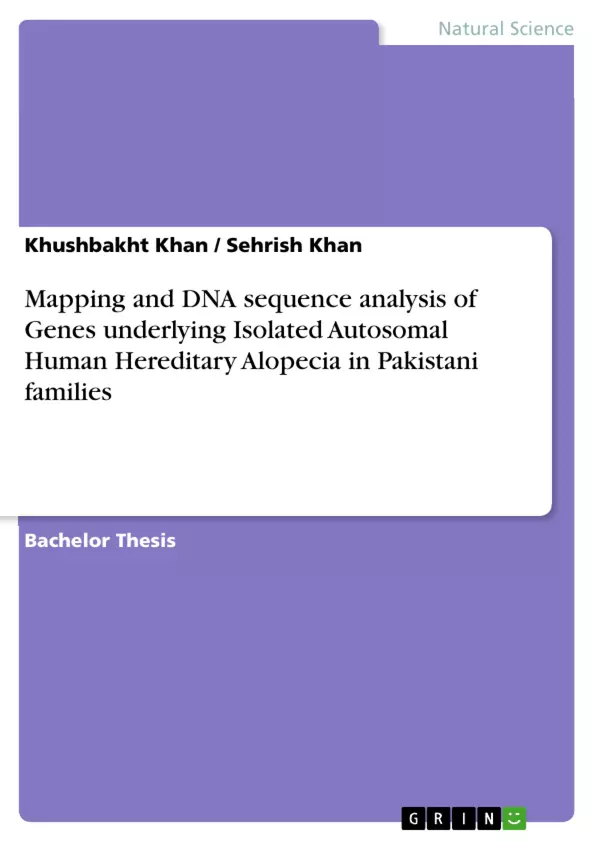Alopecia is a broad term including many forms of hereditary hair loss resulting from genetic defects affecting hair growth cycle or hair structure that vary in age of onset, severity and associated ectodermal abnormalities. The inheritance pattern of alopecia can be autosomal dominant, autosomal recessive or X-linked. Various mutations in several genes on different chromosomes are being identified which are involved in pathogenesis of inherited autosomal recessive alopecia.
In present research, two families (A&B) with isolated hereditary alopecia, residing in different zones of Pakistan were ascertained. The mode of inheritance inferred as autosomal recessive. One family was subjected to mutation screening while on other, polymorphic microsatellite markers was used for the purpose of homozygosity mapping to explicate the gene defect. Phenotypic analysis of family A shows the characteristic clinical features of hypotrichosis with sparse hair on head and rest of body and with no associated abnormality. Gene linked to this family in previous research was CDH3. So, splice-junction site and sixteen exons of this gene were sequenced but were negative for functonal sequence variant. This clearly shows mutation must be present in regulatory region of this gene.
In family B, affected individual’s shows clinical features of atrichia with papular lesions (APL) which is rare autosomal recessive disorder, characterized by occurrence of complete hair loss with the development of keratin-filled cysts. Known candidate genes (DSG4, HR, LIPH and LPAR6) were tested for homozygosity mapping via polymorphic microsatellite markers. Genotyping data showed no linkage to any of the candidate loci and therefore, their involvement in causing atrichia with papular lesions in this family is not supported.
Inhaltsverzeichnis (Table of Contents)
- Introduction
- Alopecia: A Review
- Isolated Autosomal Human Hereditary Alopecia
- Objectives
- Materials and Methods
- Patients and Samples
- DNA Extraction
- Genotyping
- Statistical Analysis
- Results
- Genetic Linkage Analysis
- DNA Sequence Analysis
- Identification of Novel Mutations
- Discussion
- Genetic Basis of Alopecia
- Implications for Diagnosis and Treatment
- Future Directions
Zielsetzung und Themenschwerpunkte (Objectives and Key Themes)
This dissertation investigates the genetic basis of Isolated Autosomal Human Hereditary Alopecia (IAHHA) in Pakistani families. The study aimed to identify genes responsible for IAHHA and analyze their DNA sequences to uncover the genetic mutations underlying this condition.
- Genetic Mapping and Linkage Analysis
- DNA Sequence Analysis of Candidate Genes
- Identification and Characterization of Novel Mutations
- Understanding the Genetic Basis of IAHHA
- Potential Implications for Diagnosis and Treatment
Zusammenfassung der Kapitel (Chapter Summaries)
The introduction provides a comprehensive overview of alopecia, focusing on IAHHA and its genetic basis. It outlines the objectives of the study, highlighting the specific goals of identifying genes associated with IAHHA and analyzing their DNA sequences.
The materials and methods chapter details the methodology employed in the research. This includes the recruitment of patients, DNA extraction techniques, genotyping procedures, and statistical analysis methods used to identify genetic linkage and analyze DNA sequences.
The results chapter presents the findings of the genetic linkage analysis and DNA sequence analysis. It describes the identification of candidate genes associated with IAHHA and the novel mutations identified in their sequences.
The discussion chapter analyzes the results and interprets their significance. It discusses the implications of the findings for understanding the genetic basis of IAHHA, its potential applications for diagnosis and treatment, and future directions for research.
Schlüsselwörter (Keywords)
The main keywords and focus topics of this dissertation include: Isolated Autosomal Human Hereditary Alopecia (IAHHA), genetic mapping, linkage analysis, DNA sequence analysis, gene mutations, Pakistani families, genetic basis of alopecia, diagnosis, treatment, future research.
- Quote paper
- Khushbakht Khan (Author), Sehrish Khan (Author), 2014, Mapping and DNA sequence analysis of Genes underlying Isolated Autosomal Human Hereditary Alopecia in Pakistani families, Munich, GRIN Verlag, https://www.grin.com/document/286264



